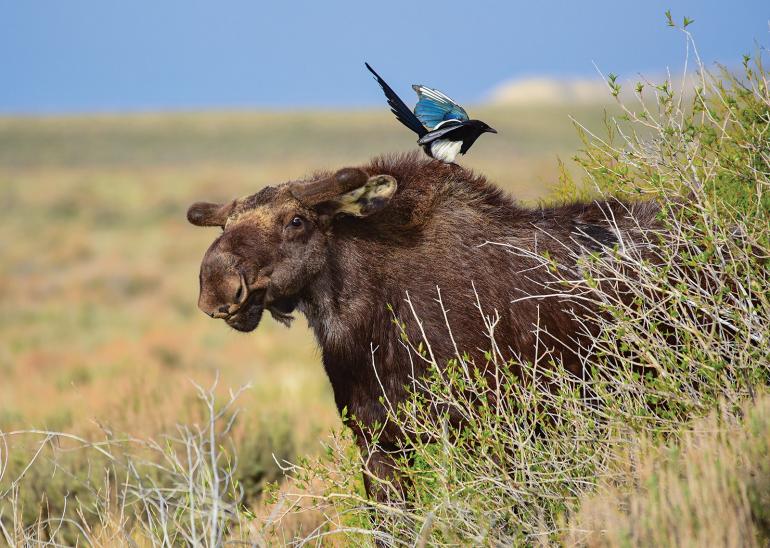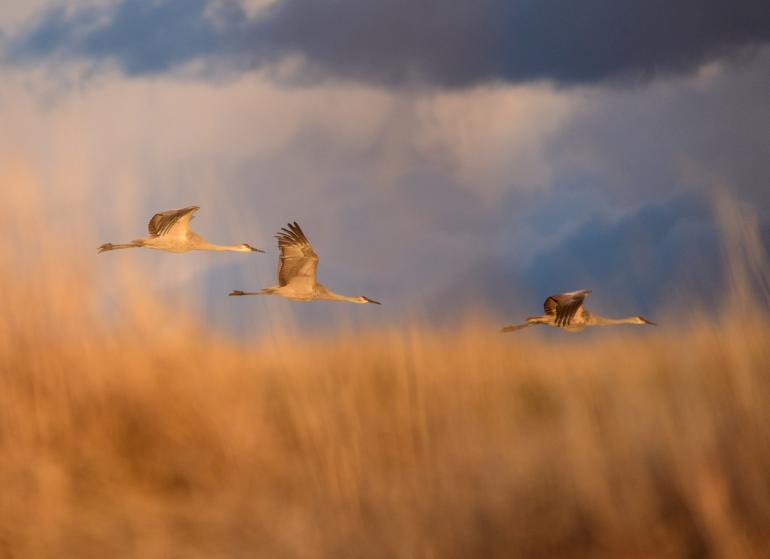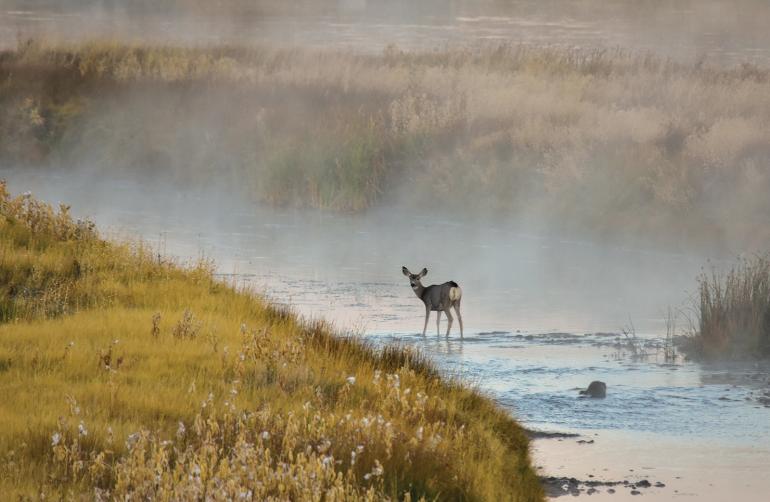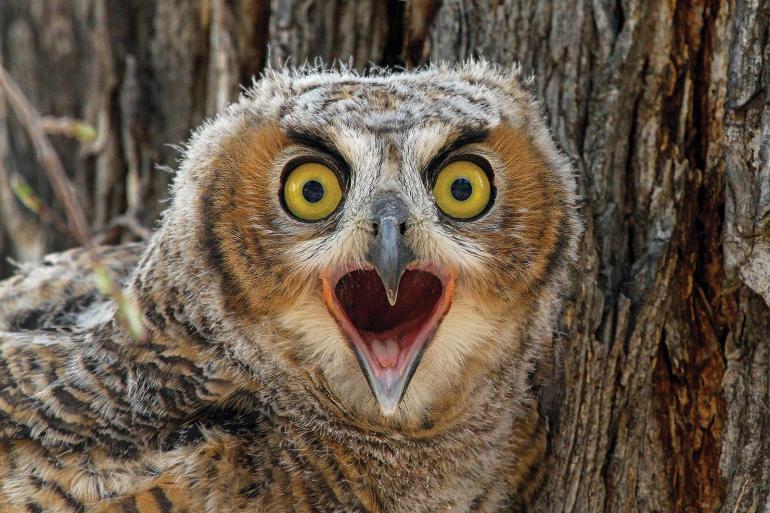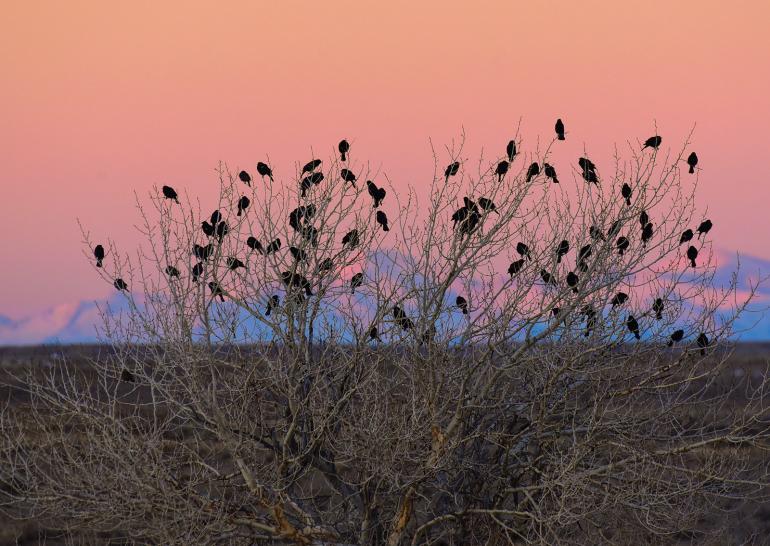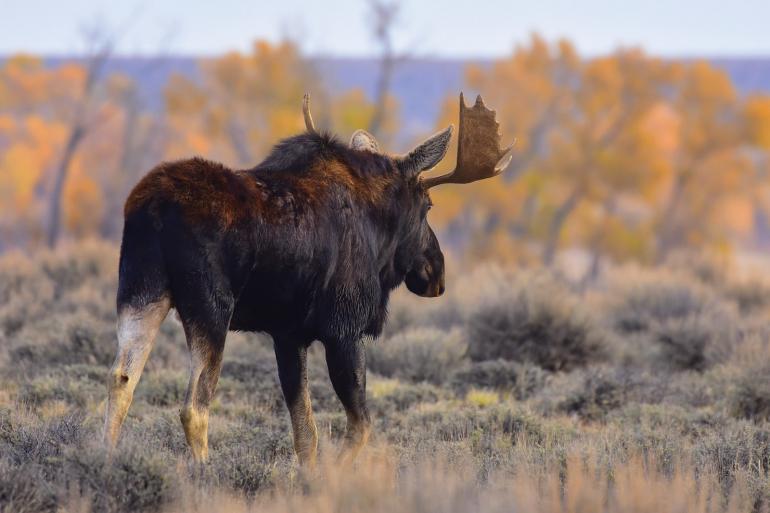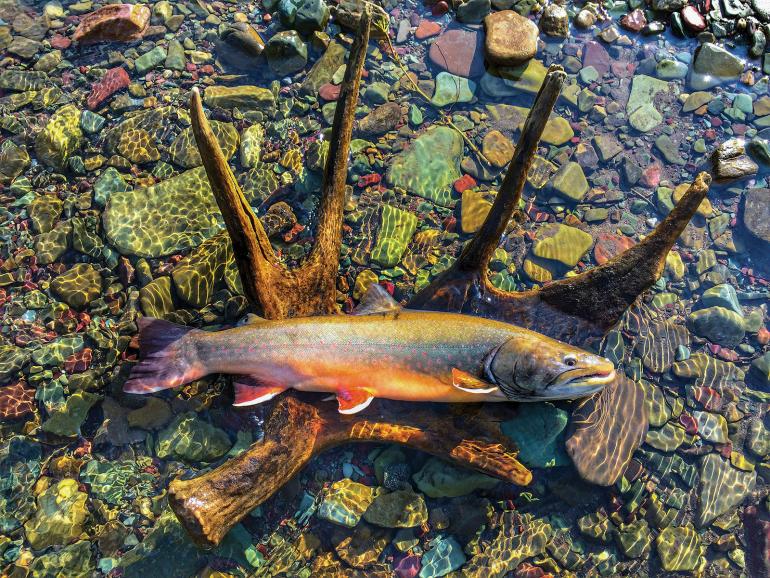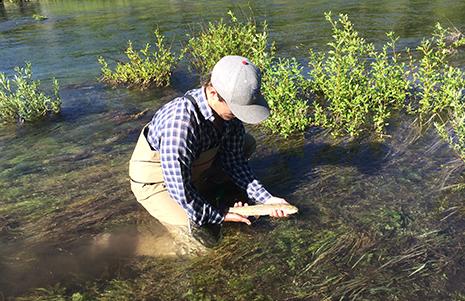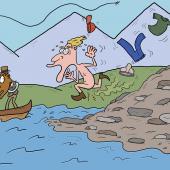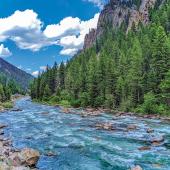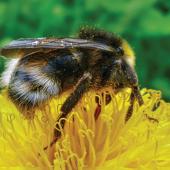The Natural State
Three local conservation groups fight ongoing battles to preserve fish and wildlife habitat in southwest Montana: Sacajawea Audubon Society, Gallatin Wildlife Association, and the Madison-Gallatin chapter of Montana Trout Unlimited.
Bozeman is surrounded by wildlife habitat. We all know this—herds of deer and elk graze the pastures off Springhill Road, trout leap out of the water to snatch grasshoppers on the Madison River, eagles soar high above the crest of the Bridger Range. It would seem as though we’re doing everything right to look after southwest Montana’s fauna. In many ways, we are. People in the Gallatin Valley care about wildlife, and caring is the first step. But things get complicated when the conversation turns to management. Protecting habitat—let alone the animals themselves—is an elaborate balance between ideals and reality; predators and prey; intervention and leaving be. At times, wildlife management seems like a paradox. If we want the natural world to exist in its natural state, shouldn’t we just... do nothing?
Well, the ship has sailed on a passive approach. Yes, humans are natural beings, just like other animals, but our presence, in such great numbers, has thrown the ecosystem out of whack. We’re mowing down forests and watering fields of grass, opening all-you-can-eat buffets for ungulates. We’ve dammed rivers and sullied fish populations with hatchery transplants. Our wetlands have been irrevocably altered—first by killing off beavers, and now by draining them to build houses. Look out across the valley. Beautiful as it is, a lot has changed over 200 years.
Thankfully, Bozeman is home to some excellent conservation groups. And we’re finding that the best results come from combining specialization with collaboration. While these groups each focus on specific subsets of wildlife, they all work together toward common goals. With help from the average citizen, those goals are attainable. Here’s a rundown on three small, hardworking organizations that are bringing sustainable wildlife management to fruition.
More Than Birds
The far-reaching efforts of Sacajawea Audubon Society.
by Jack Taylor
On the east side of downtown Bozeman, between the Village luxury-housing development and I-90, sits a 40-acre piece of land that looks almost the same today as it did when William Clark first explored the valley. Willow boughs spring and bend from wet bogs, aspens and cottonwoods stand tall on higher ground, beavers swim lazily in shallow pools, whitetail graze the thickets, and dozens of species of birds streak the skies. Among a sea of pavement, brick, glass, and steel, it’s hard to imagine such biodiversity sustaining itself naturally. But if the habitat exists, the animals will come—just as they always have.
The Indreland Audubon Wetland Preserve—colloquially known as “the Wetland”—is the latest conservation achievement of Sacajawea Audubon Society (SAS). Until recently, this urban wildlife sanctuary was slated to be drained and developed, but after years of persuasion, SAS convinced the developers to donate the land as a nature preserve in 2018. The land is now owned in full by SAS, and based on the group’s track record, we can rest assured that it’s in good hands.
SAS’s roots trace back to the early 1900s, when birders first started counting species in southwest Montana. Over the decades, a birding community emerged from a patchwork of individual enthusiasts. In 1958, once there were enough members to register with the National Audubon Society, the first SAS monthly meeting took place at the Montana Power Company building in Livingston. Holistic conservation was a focus from the start—not just birds, but all flora and fauna. The pending Wilderness Bill was a topic of discussion. Annual Christmas Bird Counts became an established tradition; members gathered information on avian ecology and migration patterns. SAS moved to Bozeman in 1967, when the Bozeman Audubon Screen Tour Committee helped revitalize the chapter from a decline in membership. Turns out, people liked seeing footage of wildlife in their natural habitats long before Planet Earth was on Netflix.
Participation in SAS’s monthly meetings grew steadily throughout the 1970s. It was a hot time for conservation, with the Ramsar Convention, Clean Water Act, and Endangered Species Act all being passed within a three-year period. Public interest in wildlife habitat blossomed. SAS’s field trips started taking people to different wetland and upland environments around southwest Montana, educating the public on all kinds of wildlife. Today, SAS president Loreene Reid recounts all the times she’s heard people say, upon returning from a field trip, “I never realized how connected I wanted to be with nature.” And this has been going on for 50 years.
SAS gathered ecological data to support the Absaroka-Beartooth Wilderness Bill in 1978, then again for the Lee Metcalf in 1983. Around the same time, SAS helped persuade FWP to purchase the old Bozeman dump, which was converted to the East Gallatin Recreation Area (now Glen Lake Park). “We knew this area had the most diverse bird population in the Gallatin Valley,” says Loreene. “The ponds allowed many waterfowl species to stay over the winter.” After seizing that opportunity, SAS also adopted oversight of the Forest Service’s Kirk Hill Nature Area.
All the while, SAS has been on a mission to educate the public on conservation. Their meetings are free and open to the public. Anyone can join a field trip and see the habitat with a wildlife expert. In fact, earlier this year, Loreene led the O/B staff on a bird count. We counted 105 unique species of birds—all within 24 hours—between the Wetland, Glen Lake Park, Missouri Headwaters State Park, and Bench Rd. south of Three Forks. We spotted the rarest bird to be observed that season: a snowy egret taking a low flight right into the Wetland. And some of us couldn’t tell a robin from a warbler when we first set off.
It’s no coincidence that a group so focused on educating the public has also been one of the most successful with conservation achievements. After all, conservation groups will never be able to outbid private interests, either by lobbying politicians or purchasing huge swaths of land outright. Appealing to sensibility is the next possible discourse. Politicians and developers are people, too, who can come around after seeing the wildlife habitat up-close and personal. A legacy at stake is a powerful incentive for positive change.
But SAS isn’t a one-man band—far from it. The group collaborates with many different local and national conservation groups. “We had the local Trout Unlimited chapter do all the legal work for our water rights in the Wetland,” says Loreene. “We work with the city on bird-friendly landscaping. And we work with consultants—no one does wetlands more than Ducks Unlimited. We don’t have any staff to pay, so we hire the best in the business.” That’s right: SAS is 100% volunteer-run, and always has been.
“Somebody’s gotta stand up and yell it from the mountaintop,” says Loreene Reid, SAS president.
Today, SAS has over 1,000 members and covers the entire area from West Yellowstone and the Madison Valley, up to the Bridgers and Crazies, and over to the western Beartooths. Their efforts today are largely focused on remediating the Wetland, which needed some cleaning up after years of neglect. SAS calls its volunteer work crew the “Busy Beavers,” an homage to the original source of the wetland: beaver dams. Projects include removing invasive plants (using insects instead of herbicide), maintaining adequate flows to the wetland, and gathering information on wildlife inhabitants. On the horizon, SAS plans to enhance the Wetland with deeper ponds, to provide a cool-water reservoir for the East Gallatin. “This will help improve both the wetland and stream habitats, because fish downstream will thrive in the cooler water,” says Loreene.
It’s clear that SAS’s conservation efforts reach far beyond padding out numbers for bird counts. Good habitat for birds is good for pretty much any other animal. And grassroots conservation movements are where it all starts. Somebody’s gotta stand up and yell it from the mountaintop,” says Loreene. You can see the return on that call to conserve first-hand, right in downtown Bozeman. So take a stroll over to the Wetland, join SAS for a monthly meeting, or head afield with some of the most experienced birders around. Chances are, you’ll realize there’s a lot more to it than counting birds. Just don’t be surprised if you find a new hobby.
The Silent Majority
Gallatin Wildlife Association gives animals a voice.
by Corey Hockett
Southwest Montana is renowned as a place where wildlife roam free. A place where the hills are vast, forests are deep, and the rivers run cold and clear. The Greater Yellowstone Ecosystem (GYE) is one of the most intact swaths of land in the Lower 48. But that land is shrinking. Water quality is degrading. More and more humans are going farther into wild places. We are staying longer, our presence encroaching on the animals that live there.
If these critters could talk, they would likely take on the persona of the Gallatin Wildlife Association (GWA), a small nonprofit based here in Bozeman. The advocacy group started in 1976 as a sort of hook-and-bullet organization fighting for wildlife and fisheries. The original crew consisted of devout hunters and anglers. Over the years, their membership has shifted slightly away from the traditional sportsman, but for over four decades, their mission has remained the same: “to advocate for science-based management of public lands for diverse public values, including but not limited to hunting and angling.” Currently, they’re involved in a multitude of issues around the Greater Yellowstone, and all of them have something to do with the protection of habitat.
“At some point, you have to look at these places and say, ‘there’s nowhere else to go,’” says Clint Nagel, GWA President. “That’s what we are trying to prevent.”
Like many others in the Gallatin Valley, Clint is worried about human impact on the environment. He’s concerned that the status quo is okay with sewage pollution entering the Gallatin River near Big Sky. He’s agitated that the Department of Environmental Quality (DEQ) isn’t holding Spanish Peaks, Boyne Resorts, and the Yellowstone Club accountable for what he believes are clear violations of the Clean Water Act. He’s confused as to why more people and groups aren’t talking about the issue.“That whole area is a mess when it comes to nutrient pollution,” Clint says. “Because DEQ won’t hold them accountable, we have to hold them accountable.”
Earlier this year, GWA joined Cottonwood Environmental Law in filing a lawsuit against the Big Sky Water & Sewer District to address their leaking sewage ponds. They are also pursuing litigation for an unfenced treatment plant and the detrimental effects of using treated wastewater to irrigate golf courses.
On the terrestrial side of things, GWA is focused on getting Wilderness Study Areas (WSA) designated as Wilderness. The main one being the Hyalite-Porcupine-Buffalo Horn WSA, as it is some of the last remaining critical habitat in the GYE. They’re pushing to get wildlife crossings installed across highways that divide critical habitat—one near Bozeman Pass and another down Gallatin Canyon. They’ve got a slew of other projects, too, including writing papers on the effects of artificial elk feeding, filing lawsuits in defense of grizzly bears, and providing testimony on how hunting regulations have consequences that ripple out into the ecosystem.
“That whole area is a mess when it comes to nutrient pollution,” Clint says. “Because DEQ won’t hold them accountable, we have to hold them accountable.”
To this end, Clint asserts that today’s wildlife-management practices are almost contrary to the ecological principles he learned in college. “It seems that a lot of people are ignoring the fact that everything in an ecosystem is interconnected,” he says. “There’s a balance, and we’re forgetting to look at the whole picture.” He points to the narrative around predators, noting that so much of what we hear about wolves is that they are terrible because of how many elk they kill. Yet, this year, we have groups and legislators looking to loosen the hunting regulations on elk because their population is too high. Clint ponders the paradox: “How can both things be true at the same time?”
GWA has over 100 members, but its core contingent remains small. It’s a passionate group of folks working on a shoestring budget. They go to bat for the silent majority—animals that can’t step up to the plate themselves—taking on hot-topic issues within agriculture, development, and recreation. Because of their insistent stance on habitat protection, they are painted as radicals in the eyes of some, including moderate conservationists.
Clint laments that as outdoor recreation becomes more popular, so do the incentives to prioritize selfish pursuits over maintaining a sustainable ecosystem. “Just because you’re a recreationist who likes to go up in the mountains to hike and climb doesn’t mean that you’re a conservationist,” he says. This is a key struggle for GWA, especially when it comes to recruitment. Advocating for habitat isn’t as sexy as ripping down a trail on a mountain bike. There isn’t an adrenaline fix associated with designating Wilderness Areas or fighting for wildlife corridors. This creates a divided constituency, some of whom, Clint asserts, are in denial.
“The recreation divide is frustrating,” he says. “But what’s more frustrating is that you have these big non-government-organizations that are saying ‘yeah, we can do it all.’ Where is the science that says that we can do it all?”
On its website, GWA says that the Gallatin area is a dichotomy of two issues—the rivers and the forests, which are experiencing misuse and overuse from one source: humans. Too many people wanting to do too many things. The solution to such a problem seems nothing short of a societal regime change, one that involves restraint and the recognition that value exists outside of what can be measured by money or our adrenal glands. Which is to say that getting everyone to buy in is not going to be easy.
But easy is not what GWA expects. It’s not anything they’ve ever had. None of their victories come at the drop of a hat. None of their triumphs even land anyone a paycheck. And they plug away regardless, using science and the law to defend and protect what yet remains wild in southwest Montana.
Against the Current
The Madison-Gallatin chapter of Trout Unlimited helps protect our cherished waters.
by Hannah Kearse
With one year under her wader-belt as president of the Madison-Gallatin chapter of Trout Unlimited (MGTU), Sarah Clark is eager to cast more light on the organization’s meeting season. The monthly gatherings provide the foundation to improve and protect southwest Montana’s streams and fisheries, and she wants them to be as productive as possible. But their board is smaller than the one Clark joined 10 years ago, which is one of the chapter’s biggest challenges. “With a small volunteer board carrying the bulk of the tasks,” Clark says, “it can be tough to have the time to tell each story.”
Clark, a local fishing guide, joined the nonprofit to get a better understanding of the resource that provides her with one of her favorite activities: fishing. She got involved in making southwest Montana’s fisheries better, and she hopes more people will, too—because the chapter could use it. “I thought it would be good for me to learn more about our local watershed and pressing issues,” Clark says. “As well as give back some of my time to the rivers and the fish.”
She couldn’t have chosen a better organization. MGTU has accomplished much since its inception in 1968, when noted anglers Bud Lilly and Dan Bailey helped formed the chapter. Notable achievements include helping to implement wild-trout management in the ’70s and protecting stream access in the ’80s. More recently, they’ve focused on stream and native-fish restoration in waters all around southwest Montana.
The nonprofit’s track record has continued to shine since Clark got involved. MGTU’s range is wide, its influence strong. This April, in Montana’s Meagher County District Court, the group assisted in a major win against Sandfire Resources to block construction of the Black Butte Mine on the Smith River. The group provided funding for the legal process, along with a testimony that was helpful in guiding the court’s decision to enforce the Montana Environmental Protection Act and the Metal Mine Reclamation Act. This decision took the Australian-owned copper mine one step back from approval, and made Sheep Creek more likely to be protected as a critical spawning ground and tributary of the Smith River. “We’re very proud of this decision,” Clark says. “Even though we know we need to be prepared for what could be next. For now, we’re celebrating.”
The group also has boots on the ground serving southwest Montana’s fisheries. They’re improving impaired streams that flow into the East Gallatin River, and their efforts are proven by cleaner water and the growing presence of trout. A restoration project on Dry Creek is a particularly successful example of the organization’s efforts. Erosion had deteriorated Dry Creek into an over-saturated, low-flow creek. The Dry Creek Canal was stealing the stream’s cold water, and the de-vegetated banks were muddying the remaining water into oblivion. But MGTU took note and stepped up, recognizing the importance of restoring this important tributary.
“We’re very proud of this decision,” Clark says. “Even though we know we need to be prepared for what could be next. For now, we’re celebrating.”
Today, Dry Creek flows year-round into the East Gallatin, and many of its steep, eroding banks have been leveled with the natural floodplain. MGTU financed and executed the entire effort, returning Dry Creek to a spawning destination for trout. “You can see the difference,” Clark says. “Just in how much more trout are in the creek than before.” The results were also visible to the Montana Department of Environmental Quality (DEQ), which noticed the chapters’ success and bankrolled a new phase, which will entail another mile of stream work. This phase is set to start next year.
Another important East Gallatin River tributary is Mandeville Creek, which runs through the middle of Bozeman. Mandeville is on the DEQ’s list of impaired waters. Historically, trout used this spring creek as spawning grounds, but it now sits in the urban currents of Bozeman’s rapid growth. Luckily, Clark and MGTU thrive in this kind of effort. “I really love our work that focuses on our beloved urban streams,” Clark says, pointing out that healthy streams are not only good for trout, but for other aquatic creatures—and for people, too. A stroll alongside Mandeville Creek as it meanders past Bozeman High, with its lush grasses, clear water, and occasional muskrat, reminds passersby that nature can—and should—be all around us, even when in town.
The Mandeville project will also embark with a new kind of partner: the developer. Bozeman’s real-estate developers don’t always disregard stream health in pursuit of profit, but it’s rarely on the top of their priority list. Clark says this particular one is open to taking a more active role in restoring Mandeville Creek. The groundwork of a collaborative project is already underway, and only time will tell how it works out. Regardless, the MGTU board will start developing a plan to repair the spring creek during the upcoming monthly meetings. Clark hopes the Mandeville Creek project will be an example of how urban areas can grow while protecting the streams that flow through them. This kind of work takes years to accomplish, and MGTU members often feel like they’re casting into the wind. But through their persistence and patience, they find ways to land big wins for streams in southwest Montana—and for every one of its residents, who can enjoy the clean, healthy streams flowing through their community.



